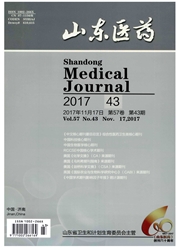

 中文摘要:
中文摘要:
目的探讨骨癌痛大鼠背根神经节IL-17与磷脂酰肌醇3-激酶/蛋白激酶B(P13K/Akt)信号通路的关系。方法清洁级成年雌性未交配SD大鼠44只,9周龄,体重180~200g,采用随机数字表法分为4组(n=11):假手术组(S组)、骨癌痛组(B组)、骨癌痛+IL-17抗体组(BI组)和骨癌痛+PBS溶剂组(BP组)。B组、BI组和BP组左胫骨骨髓腔注入Walker256癌细胞悬液10仙l的方法制备大鼠骨癌痛模型,S组左胫骨上端骨髓腔注入Hank液10μl。造模后9~11d,BP组和BI组分别鞘内注射PBS20μl/d、IL-17抗体(1mg/ml)20μl/d,1次/d。于造模前(T0)、造模后5d(T1)、造模后9d给药前(T2)、造模后11d给药后30min(T3)时测定机械痛阈。于造模后11d机械痛阈测定结束后,采用Western blot法测定背根神经节P13K、磷酸化Akt(p-Akt)和Akt的表达水平。结果与S组比较,B组、BI组、BP组T1-3时机械痛阈降低,背根神经节P13K和p-Akt表达上调(P〈0.01);与B组比较,BI组T3时机械痛阈升高,背根神经节P13K和p-Akt表达下调(P〈0.01),T1、2时机械痛阈差异无统计学意义,BP组上述指标差异无统计学意义(P〉0.05)。各组背根神经节Akt表达比较差异无统计学意义(P〉0.05)。结论背根神经节IL-17可能通过激活P13K/Akt信号通路参与大鼠骨癌痛的维持。
 英文摘要:
英文摘要:
Objective To investigate the relationship between interleukin-17 (IL-17) and phosphatidylinositol 3-kinase (PI3K)/protein kinase B (Akt) signaling pathway in the dorsal root ganglion (DRG) of rats with bone cancer pain (BCP). Methods Forty-four pathogen-free adult female unmated Sprague-Dawley rats, aged 9 weeks, weighing 180-200 g, were randomly divided into 4 groups (n = 11 each) using a random number table: sham operation group (group S) ; BCP group (group B) ; BCP + IL- 17 antibody group (group BI) ; BCP + phosphate buffer solution (the solvent) group (group BP). BCP was induced by injecting Walker256 mammary gland cancer cell suspension 10 μl into the medullary cavity of the left tibia in B, BI and BP groups, while group S received intra-tibiat inoculation of 10 μl Hank's solution. At 9-11 days after BCP, PBS 20 μl/d and IL-17 antibody ( 1 mg/ml) 20 μl/d were injected in- trathecally once a day in BP and BI groups, respectively. Before BCP (T0) , at 5 days after BCP (T1 ), before administration on day 9 after BCP (T2) and at 30 min after administration on day 11 after BCP ( T3 ) , the mechanical pain threshold was measured. After measurement of the pain threshold on day 11 after BCP, the animals were sacrificed, and the DRGs of the lumbar segment ( L4-6) were removed for determination of the expression of PI3K, phosphorylated Akt (p-Akt) and Akt by Western blot. Results Compared with group S, the mechanical pain threshold was significantly decreased at T1-3 , and the expression of PI3K and p-Akt in DRGs was significantly up-regulated in B, BI and BP groups (P〈0.01). Compared with group B, the mechanical pain threshold was significantly increased at T3 , the expression of PI3K and p-Akt in DRGs was significantly down-regulated (P〈0.01) , and no significant change was found in the mechanical pain threshold at T1,2 in group BI, and no significant change was found in the parameters mentioned above in group BP (P〉0
 同期刊论文项目
同期刊论文项目
 同项目期刊论文
同项目期刊论文
 期刊信息
期刊信息
